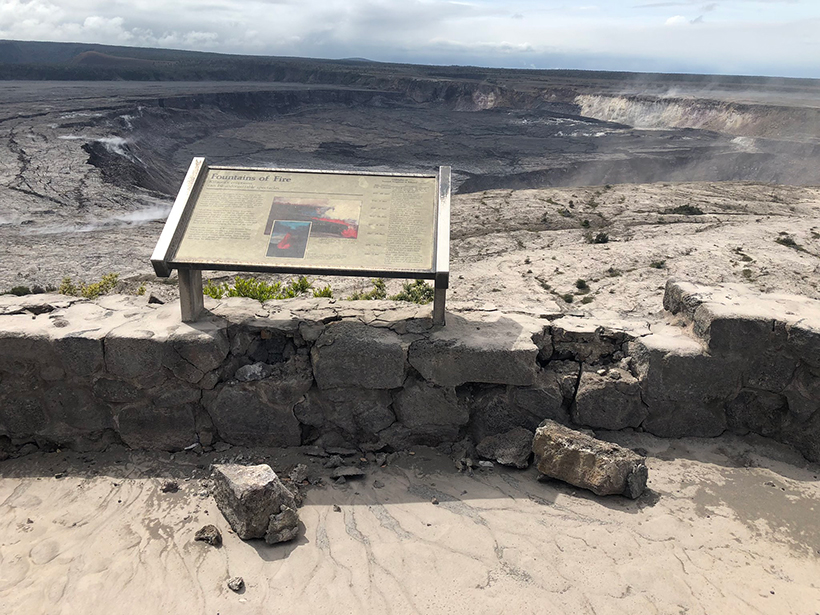The U.S. Geological Survey (USGS) is searching for a new home for the Hawaiian Volcano Observatory (HVO), after powerful earthquakes generated by the eruption of Kīlauea in 2018 damaged the previous facility beyond repair.
The facility is perched on the very rim of Kīlauea’s caldera, which was shaken by thousands of earthquakes, underground explosions, and massive slumping as Halema‘uma‘u Crater within the caldera collapsed and the caldera’s walls caved in.
The building now has deep cracks in its foundation, floors, and walls, as does the neighboring Jaggar Museum, said Jessica Ferracane, spokesperson for Hawai‘i Volcanoes National Park, which hosts HVO and owns the damaged building. “But what’s more of a problem is what’s underneath,” she said.
Geomorphology assessments documented significant earth movement around both buildings and the potential for significant additional movement in the future. The HVO building rests between several faults on the edge of Kīlauea’s caldera.
There’s evidence that settling below the south corner of HVO’s building began before the start of seismic activity, Ferracane added.
Short-Term and Long-Term Relocation
HVO scientists and staff have been working out of temporary offices in the town of Hilo, about 45 minutes from the volcano, since the facility was evacuated in May.
In an interview with local media, Tina Neal, scientist-in-charge of HVO, said the USGS was working with stakeholders, the National Park Service, and Hawaii’s congressional delegation to find a long-term solution.
Neal confirmed that locating a facility on Oahu, the state’s most populous island, was one possibility being discussed. Sen. Mazie Hirono (D-Hawaii) has questioned the proposal, saying locating an observatory on an island with no active volcanoes “doesn’t seem to make a lot of sense.”
“We’ve really enjoyed being there [on the rim of the caldera]—it’s very nice to look out the window and see the summit of Kīlauea, but it’s not a requirement.”
HVO spokeswoman Janet Babb noted that many USGS observatories are not located directly on the volcano they monitor. The Cascades Volcano Observatory is located in Vancouver, Wash., for example, not on nearby Mount St. Helens or Mount Hood, Ore.
“We’ve really enjoyed being there [on the caldera rim]—it’s very nice to look out the window and see the summit of Kīlauea, but it’s not a requirement,” Babb said. “HVO will continue to monitor Hawaii volcanoes, regardless of where the actual office building is located.”
The park service is working with USGS to keep scientists within Hawai‘i Volcanoes National Park, Ferracane said. She noted that the observatory was established near the summit of Kīlauea by geologist Thomas Jaggar in 1912, 4 years before Hawai‘i Volcanoes National Park was formed.
“We’ve had this relationship since before the park was a park,” Ferracane said. “Being that we have two of the most active and studied volcanoes in the world, we are working with [the USGS] to keep them here.”
The 2018 eruption began suddenly on 3 May, unleashing an estimated 114 million cubic meters of lava and generating more than 60,000 earthquakes over a 4-month period. Some 716 homes were destroyed by lava in the eruption, which ended in August, nearly as abruptly as it had begun.
Neal and other scientists published a paper in January in Science on their observations of the event, which also included rare explosive eruptions at the volcano’s summit and the dramatic collapse of Halema‘uma‘u Crater and the surrounding caldera floor.
After 8 months of quiet, in March the USGS downgraded the alert level for Kīlauea to “normal.”
—Ilima Loomis ([email protected]; @iloomis), Science Writer
15 April 2019: This article corrects the date of the founding of the Hawaiian Volcano Observatory.
Citation:
Loomis, I. (2019), Hawaiian Volcano Observatory searches for a new home, Eos, 100, https://doi.org/10.1029/2019EO120621. Published on 12 April 2019.
Text © 2019. The authors. CC BY-NC-ND 3.0
Except where otherwise noted, images are subject to copyright. Any reuse without express permission from the copyright owner is prohibited.

